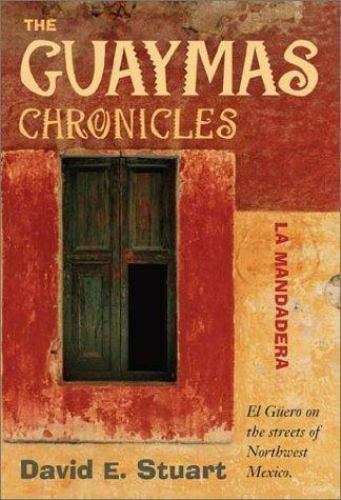 Although it’s about Mexico, this one starts off in Ecuador in the 1960s where the author was doing doctoral fieldwork for a dissertation on haciendas in that country. His work took him to a remote research station on the side of a mountain seventy miles from electricity, running water, telephones, etc. One day while riding his horse along the side of a gorge, with the bottom of a canyon almost a thousand feet below him, the horse stumbled and fell. On its way over the edge it rolled over Stuart and disappeared, leaving him badly crippled. He was rescued and eventually found his way to Guaymas, on the coast of the Sea of Cortez, in Mexico, where his fiancé, Iliana, lived. His arm was in a cast, his shoulder was out of joint, he had lost thirty pounds and was badly shaken up. Thus begins the story of his recuperation and, at the same time, the exploration of Mexican society and customs which is described here.
Although it’s about Mexico, this one starts off in Ecuador in the 1960s where the author was doing doctoral fieldwork for a dissertation on haciendas in that country. His work took him to a remote research station on the side of a mountain seventy miles from electricity, running water, telephones, etc. One day while riding his horse along the side of a gorge, with the bottom of a canyon almost a thousand feet below him, the horse stumbled and fell. On its way over the edge it rolled over Stuart and disappeared, leaving him badly crippled. He was rescued and eventually found his way to Guaymas, on the coast of the Sea of Cortez, in Mexico, where his fiancé, Iliana, lived. His arm was in a cast, his shoulder was out of joint, he had lost thirty pounds and was badly shaken up. Thus begins the story of his recuperation and, at the same time, the exploration of Mexican society and customs which is described here.
What makes this somewhat different from the usual narrative of a gringo living in a foreign community is the 25-year-old Stuart’s determination to assimilate himself fully into the life around him. His background as an anthropologist also gave him an edge when it came to observing and analyzing that life. I should explain that his interest in anthropology ran deep. Today, he is Associate Provost and Professor of Anthropology at the University of New Mexico. He is also the author of several books.
Stuart obviously likes Mexicans and is a sympathetic observer. He wasn’t interested in observing at arm’s length. He wanted to be involved in the life around him. In turn, the locals accept him. They referred to him as El Güero (Whitey). He became friends with waiters, taxi drivers, policemen, businessmen… with Mexicans of all kinds. Even when he had the opportunity to mingle a little more closely with the upper class folk in Guaymas, Stuart chose to stay closer to the street people. Perhaps he was accepted because, with his injuries and because he was not too well off, he was in worse shape than they were. They at least had families and homes and jobs.
Stuart was invited by Iliana’s family to stay in the house where he would sleep on the front porch and they would fatten him up. He was delighted to accept the invitation, mainly because he was almost flat broke. He became part of the household, along with Iliana, her little sister, her mom, little brother and a childless uncle and aunt.
It all seemed perfect. At least he now didn’t have to look for a room or some other paid accommodation. Also, he had people to look after him in his injured state. Unfortunately, there was a snag. Iliana, with whom he was in love, was surprisingly cool toward him. It was a bit of a puzzle until he discovered the reason. She was pregnant. And David Stuart wasn’t the father. That explained her initial reserve when he showed up on her doorstep. That was the end of their romance.
Despite that setback, he remained in Guaymas and enjoyed mixing with the locals. He makes many observations of those people in his chronicles. For example: “In the States we expect, even demand, a perfect world. For the taxistas, cantineros, waiters and others I knew, a great day in paradise meant: ‘I ate twice, got laid, have forty pesos in my pocket, two smokes left for bedtime, and some real friends. End of list.'”
I liked his observation of a typical Guaymas beach scene: “In contrast to stateside beaches, many adult couples necked and petted, albeit modestly, while their kids napped on the blankets with them. Babies slept on dad’s tummy. Girl friends held each other’s hands while they walked, giggling. Adult men wrapped their arms around best buddies as they sat in the sand and passed a cigarette back and forth between them. The human contact was intense, laughter was common, and generosity ruled.”
As he settled into life in Guaymas two main thrusts take over the story. One was that he “adopted” a rather unusual 11-year old street girl, Lupita. Or perhaps it would be more accurate to say that she adopted him. The other was that, being broke, Stuart needed to find a way to earn some dinero. His solution was also rather unusual.
Lupita was a homeless orphan who made something of a living shining shoes. She was abandoned by her prostitute mother when she was six years old and had somehow survived. Stuart describes her as “like something out of a Dickens novel.” She became his errand girl – a mandadera, as the title describes her. As a companion, at least, she partly took the place of Iliana. She became his teacher and a kind of junior business partner. Her knowledge of the streets helped him in numerous ways. She was good at doing deals for him when he needed to make purchases. She also became his partner in crime when Stuart was persuaded to make a living as a smuggler.
In that era, consumer goods – such as toasters, fans, blenders, air conditioners – were unobtainable in Mexico yet people still wanted them. Stuart was therefore persuaded to cross the border into Yuma and to buy these goods and bring them back into Mexico, claiming them as personal property for his own use. Then he could sell them to the people who had asked him to buy them – at a profit, of course. It was a risky business in that it was quite possible to run into problems with customs, either because he could be charged duty on the items or even refused admission back into Mexico. When Lupita hid herself in his car for one such trip, she proved quite adept at helping him past customs without problems. Thus Stuart was able to eke out a living.
The story ends with the tragic death of Lupita and it is following that heart-breaking event that Stuart decides it is time to return to his roots.
It perhaps isn’t the most exciting or dramatic story, but I found that once I was into it and got to know the characters, I had no problem turning the pages.
In my humble O: Give it a go. I think you’ll like it.
The Guaymas Chronicles – La Mandadera
By David E. Stuart
University of New Mexico Press. 2003
Available from Amazon Books: Paperback


